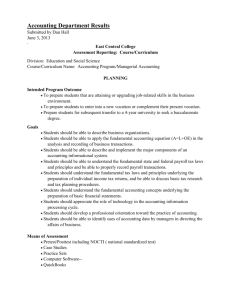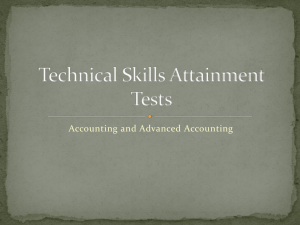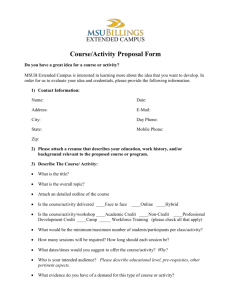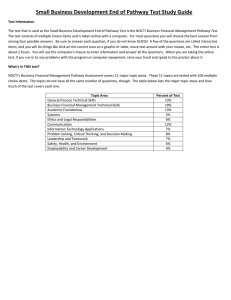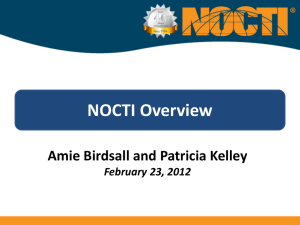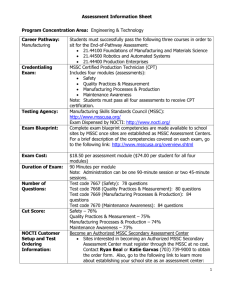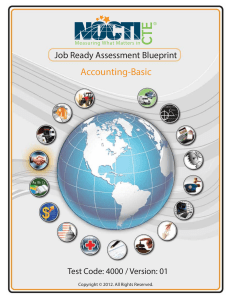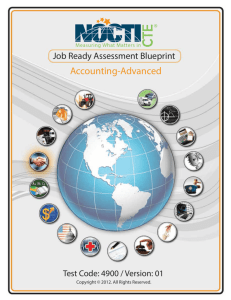Sample Articulation Agreement between postsecondary and
advertisement
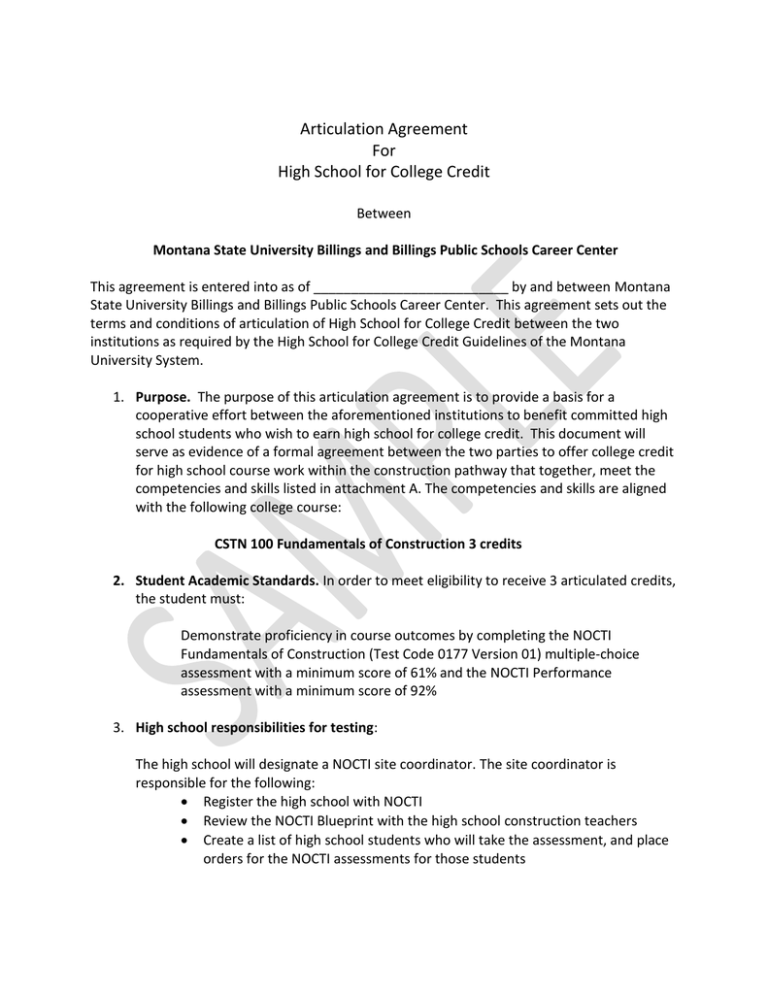
Articulation Agreement For High School for College Credit Between Montana State University Billings and Billings Public Schools Career Center This agreement is entered into as of __________________________ by and between Montana State University Billings and Billings Public Schools Career Center. This agreement sets out the terms and conditions of articulation of High School for College Credit between the two institutions as required by the High School for College Credit Guidelines of the Montana University System. 1. Purpose. The purpose of this articulation agreement is to provide a basis for a cooperative effort between the aforementioned institutions to benefit committed high school students who wish to earn high school for college credit. This document will serve as evidence of a formal agreement between the two parties to offer college credit for high school course work within the construction pathway that together, meet the competencies and skills listed in attachment A. The competencies and skills are aligned with the following college course: CSTN 100 Fundamentals of Construction 3 credits 2. Student Academic Standards. In order to meet eligibility to receive 3 articulated credits, the student must: Demonstrate proficiency in course outcomes by completing the NOCTI Fundamentals of Construction (Test Code 0177 Version 01) multiple-choice assessment with a minimum score of 61% and the NOCTI Performance assessment with a minimum score of 92% 3. High school responsibilities for testing: The high school will designate a NOCTI site coordinator. The site coordinator is responsible for the following: Register the high school with NOCTI Review the NOCTI Blueprint with the high school construction teachers Create a list of high school students who will take the assessment, and place orders for the NOCTI assessments for those students Arrange for students to take written assessment at the high school including test monitors in accordance with NOCTI guidelines. The assessments are online requiring computer stations for all test takers Obtain student written scores from NOCTI. Register students passing the written with one of the three colleges offering the performance assessment (City College Montana State University Billings, Helena College, and Great Falls College). Obtain student performance scores from NOCTI. Inform students of their assessment scores. Prepare certificate of proof for each student passing both written and performance assessment, distribute copy to student and keep one copy in high school records. 4. College responsibilities for testing: The college will designate a performance test coordinator. The test coordinator schedules the NOCTI performance test, coordinating dates and times with other Montana colleges offering the performance assessment. The test coordinator arranges for performance test evaluators in conformance with NOCTI performance test guidelines. The test coordinator enters all test results into the NOCTI database. 5. Transcripting Credit. In order to receive the articulated credits the student must: a. Apply for admission to Montana State University Billings within 24 months of High School Graduation and meet established admission requirements. b. Submit a written request to Montana State University Billings College to transcript the credit. c. Submit proof of passing scores for both the written and performance assessment (available from the high school NOCTI Site Coordinator) along with the written request. d. Credit will be recorded on the college transcript as articulated credit but will not be calculated in determining GPA. 6. Administrative Process a. A copy of this executed agreement will be forwarded to OCHE’s Two-Year and Community College Education Division at perkinscoordinator@montana.edu. 7. Tuition & Fees. Because the courses involved are at the high school level, the student pays no tuition. However, following fees may apply: a. Transcription – If there is a fee to transcript the student’s credit, the college will notify the high school NOCTI site administrator and this information will be passed on to the student. b. NOCTI charges a fee to take the written and performance assessments. The high school will pay these assessments. However, they may require the student to reimburse the high school or pay in advance. 8. Effective Date, Amendments, & Termination. a. The conditions of this agreement and specific course competencies are subject to review on an annual basis. This agreement shall continue as modified through the annual review unless terminated or amended by either party by way of a written notice at any time. b. Each institution will inform the other in writing of any institutional plans or changes that have impact on the contents of this articulation agreement prior to implementing those plans or changes. c. Written notice of intent to terminate or withdraw from this articulation agreement will be submitted by the academic head of either institution not less than one calendar year prior to the proposed date of termination/withdrawal. 9. Compliance with law. All parties to this agreement shall at all times comply with all applicable local, state, and federal law. 10. Signatures _______________________________ High School Instructor, Date _______________________________ High School Principal/Superintendent, Date _______________________________ College/University Department Chair, Date _______________________________ College/University Dean/CEO, Date Attachment A Specific Competencies and Skills Tested in this Assessment: Foundations of Safety Demonstrate understanding of the role that safety plays in the construction industry Demonstrate understanding of the idea of a safety culture and its importance in construction Demonstrate understanding of the meaning of jobsite safety Jobsite Safety and Safety Regulations Demonstrate understanding of the role of OSHA in jobsite safety Demonstrate knowledge on-the-jobsite safety, basic first aid, fire prevention, proper lifting Demonstrate understanding of appropriate safety precautions to take around common jobsite hazards Demonstrate understanding of safe behavior on and around ladders and scaffolds Define safe work procedures to use around electrical hazards Personal Protective Equipment Demonstrate the use and care of appropriate personal protective equipment (PPE) Exhibit knowledge of how to properly don and remove personal protective equipment (safety goggles) Hazard Analysis Identify causes of accidents and the impact of accident costs Define hazard recognition and risk assessment techniques Identify struck-by hazards and demonstrate safe working procedures and requirements Identify caught-in-between hazards and demonstrate safe working procedures and requirements Identify other construction hazards on the job site, including hazardous material exposure Identify construction site hazards dealing with work around cranes, loaders, excavation equipment Hand Tools Demonstrate understanding of how to visually inspect hand tools to determine if they are safe to use Exhibit understanding of the basic procedures for taking care of hand tools Demonstrate understanding of the use of hammers (e.g., claw, ball-pein, sledge) Demonstrate understanding of the use of ripping bars and nail pullers Demonstrate understanding of the use of chisels and punches Demonstrate understanding of the use of screwdrivers (e.g., Phillips, spade, slotted) Demonstrate understanding of the use of wire cutters and pliers (e.g., crimping/lineman's, locking) Demonstrate understanding of the use of wrenches (e.g., combination, crescent) Demonstrate understanding of the use of sockets and ratchets Demonstrate understanding of the use of levels (e.g., torpedo, 2-foot) and squares (e.g., rafter) Demonstrate understanding of the use of rules and measuring tools (e.g., tape, laser) Demonstrate understanding of the use of plumb bob and chalk lines Demonstrate understanding of the use of utility knives, jab saw, coping saw (dull vs. sharp) Power Tools Identify the general safety rules for operating all power tools, regardless of type Identify the general safety rules for properly maintaining all power tools, regardless of type Identify, exhibit understanding of, and use stationary power tools in a safe and appropriate manner Demonstrate understanding of the use of drills (e.g., power, cordless, hammer, and impact wrenches) Demonstrate understanding of the use of saws (e.g., table, miter, compound, slide, chop, circular) Demonstrate understanding of the use of grinders (e.g., angle) and sanders (belt, palm, and orbital) Demonstrate understanding of the use of pneumatically-powered nail guns
